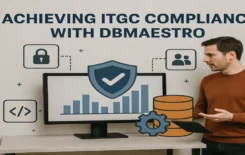Additionally, the usage of database compliance tools helps ensure that all databases are protected from breaches and unauthorized changes. The DBA should ideally be streamlining development processes with built in compliance tools and comprehensive audit trail history with real-time monitoring.
There are dozens of crucial regulatory requirements that organizations need to take into consideration today. A few of them include:
- The General Data Protection Regulation (GDPR) – Data controllers and processors need to implement security measures and process it only under one of six lawful bases – consent, contract, public task, vital interest, legitimate interest or legal requirement).
- Health Insurance Portability and Accountability Act (HIPAA) – This was created to modernize the flow of healthcare information, stipulate how Personally Identifiable Information (PII) maintained by the healthcare and healthcare insurance industries should be protected from theft.
- Sarbanes–Oxley Act (SOX) – Also known as the Public Company Accounting Reform and Investor Protection Act, this set of rules set new or expanded requirements for all U.S. public company boards, management and public accounting firms to take accountability for any mishaps.
Related: GDPR Compliance
The Database and Compliance
Times are changing. Databases are now being subjected to threats that cannot be handled by traditional security tools such as firewalls, intrusion detection, prevention systems, and other perimeter defenses. Even the basic set of security features typically offered by database vendors can be easily bypassed.
The threat landscape is constantly evolving. For example, attacking through backdoors inserted inside databases has become the norm. DBAs typically don’t have time or resources to deal with security. Hence, these vulnerabilities are often overlooked and eventually exploited to harvest sensitive data.
Here are few of the risks that organizations are facing today:
- Governance Problems – Lots of sensitive data is saved in databases and accessed by dozens (sometimes hundreds) of privileged users simultaneously. This type of threat can be malicious or at times unintentionally done by less-knowledgeable stakeholders.It’s no coincidence that more and more regulatory compliance requirements are now focusing on privileged workers/developers and permission management, with special attention being given to those whose actions are going unmonitored with no audit trail.
- Software Vulnerabilities – As databases grow in complexity, they become more prone to attacks. These flaws can range from minor ones to weaknesses that allow unauthorized users to bypass the built-in access control mechanism, escalate access privileges, and hijack the database.Privilege escalation attacks are relatively common, and can occur when an internal or external user is able to achieve additional access to the database system beyond his level of authorization. This is achieved by exploiting vulnerabilities within the database management system.
- Incompetent Security Tools – As mentioned earlier, despite their promises to combat malicious activity such as SQL injections, traditional perimeter defenses such as firewalls and intrusion detection systems/prevention systems (IDS/IPS) are proving to be seriously inadequate. The main reason behind this weakness is that these types of security solutions capabilities are usually based on signatures, which hackers can easily evade today. IPSs are also incapable of detecting sophisticated attacks that exploit vulnerabilities specific to database software.
Did You Know?
Non-compliance costs organizations an average of $4,005,116 in
revenue losses, more than twice the cost of
maintaining compliance.
Automated Compliance is Here
Compliance may sound to many as a scary thing, but its entire purpose is to safeguard personal data by improving security standards and elevating transparency. Having a modern solution in place can not only optimize your development metrics, but can also automate your compliance.
The three main things made possible by database compliance tools are:
Enforcing Roles, Responsibilities, and Policies
Security and governance tools allow you to enforce organizational policy, manage permissions, define roles, and meet compliance regulations, all while creating a fully detailed audit trail of all activities. You can define roles and policies, specifying access, duties and rules for database activities.
Doing so allows DBAs to prevent unauthorized and undocumented changes to the database and keep team members from straying from defined processes. A comprehensive solution should be able to provide you with out-of-the-box policies and support for customizable project-specific policies.
Furthermore, a detailed history of all database activities carried out in all environments can be kept automatically. All changes and attempted changes are logged, detailing who they were made by, complete with a timestamp and IP address for the user. This essentially secures the entire parameter.
Database Release Automation for Optimal Code Quality
Smooth development pipeline enables you to model the release process and path to production, while predicting errors or conflicts that might prevent a successful deployment. You can thus gain full visibility and insight into your database release pipelines– from development to release.
These platforms support seamless integration with all sources of database changes, including scripts created by devs or third-party database source control tools. The release process works with standard SQL coding, and does not require any intermediate language like XML or an associated translator.
Once you can package, verify, deploy and promote database changes securely, you can get better at preventing configuration drift and non-policy changes to your code. This effectively improves your code integrity and provides your organization with another effective layer of defence.
Real-Time Monitoring with Enhanced Visibility
Enforcing version control best practices and change policy for database development across all teams also helps. For example, a check-in/out system significantly reduces application downtime caused by database-related human errors, allowing you to get proactive with your compliance.
Database changes are validated against schemas and relevant content, while preventing unauthorized and out-of-process changes. This ensures that all changes are properly logged, something that significantly boosts visibility and also provides you with a comprehensive audit trail – automatically.
Did You Know?
Data breaches cost, on average, $1.55 million less for companies that have fully deployed automated security technology than for businesses who have no deployed automated security.
The aforementioned steps can be enforced with a capable automation solution that will help you manage your ecosystem smoothly, while staying on top of things in real-time for optimal compliance performance. The bottom line is that you cannot get the job done with traditional tools and manual labor.
Final Thoughts
While it is not the direct responsibility of the DBA to develop and enforce compliance regulation, it is definitely his responsibility to investigate, install, and manage the technology that supports and ensures database security and compliance. The aforementioned tools can help achieve high security levels.
Only the best database compliance automation tools can help monitor internal controls to ensure that all regulations are met always. Get started now.





